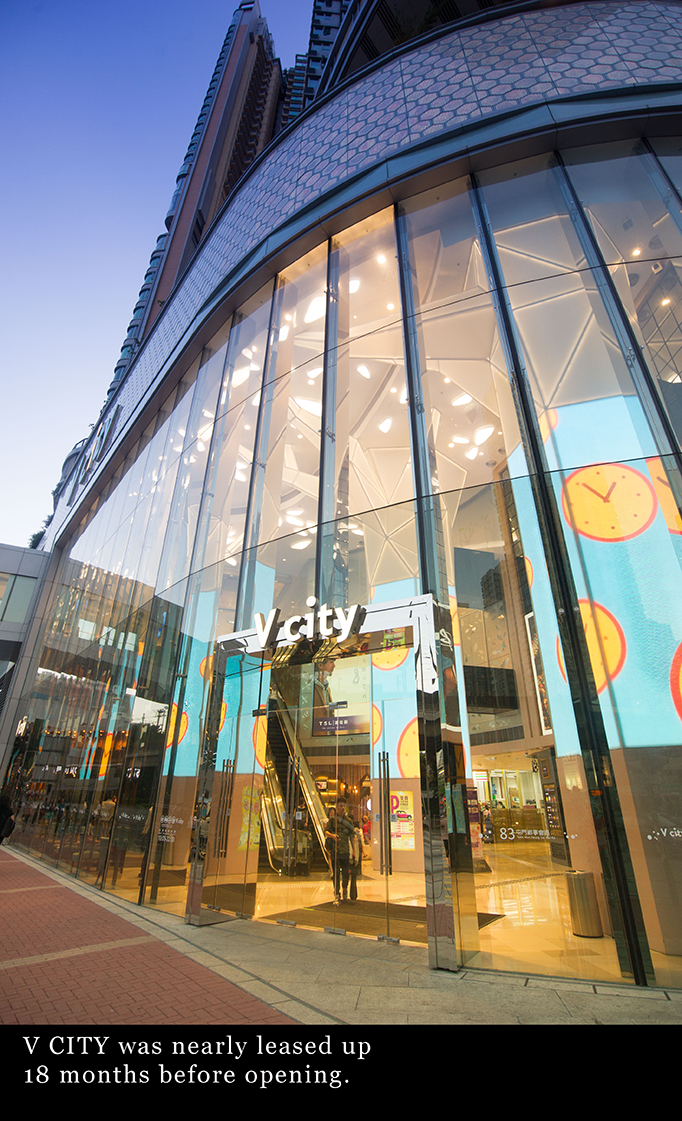
Shoppers in Hong Kong traditionally spent their money in the mainstays along Victoria Harbour — Causeway Bay, Central, Mong Kok, Tsim Sha Tsui — where major shopping malls house an amazing density of luxury brands, local boutiques and fast-fashion retailers. But high rents have led to a northward move toward the border with mainland China. In particular, Tuen Mun, in northwest Hong Kong, has seen explosive growth, thanks to the influx of Chinese tourists over the past few years. Once an area whose aging population and distance from the city’s financial hubs tended to repel retailers, it is now a place whose quality of life has improved dramatically and where young couples choose to settle and start their families.
V City, a shopping center developed in conjunction with a residential project by Sun Hung Kai Properties, leased out 75 percent of its retail space almost 18 months before the mall’s opening. Large international retailers set up stores in the mall, including Agnès B., Muji and Uniqlo. In total, nearly 130 retailers and restaurants operate in V City’s 300,000 square feet of retail space. In the third quarter of last year, some 13 million shoppers visited V City shops and restaurants, up by 8 percent from the year-ago quarter, and they spent roughly $68 million in the aggregate, up by 12 percent. Spending per customer typically falls between $100 and $380. Early projections for V City’s 2015 total sales ranged between $271 million and $284 million.
A short walk away is TMT Plaza, with 1 million square feet of retail space spread over five stories. Like V City, TMT Plaza primarily serves the local community, mainly young shoppers roughly between 18 and 35. To ensure maximum foot traffic, footbridges connect the mall to two smaller shopping centers and the town hall. TMT Plaza serves 320,000 shoppers on the weekdays, between 360,000 and 380,000 per day on the weekends, and about 400,000 during Christmas or Chinese New Year.
Causeway Bay is the world’s second-most-expensive retail location, according to Cushman & Wakefield. The district’s average yearly shop rent comes to $2,399 per square foot. Shop rents at Tuen Mun, meanwhile, are a comparative bargain: Yearly rents at TMT Plaza range from $155 per square foot to $1,084 per square foot, and V City rents run even lower, at some $77 per square foot to $434 per square foot.
The number of mainland Chinese tours to Hong Kong dropped by 10 percent this year, according to Michael Wu, chairman of Hong Kong’s Travel Industry Council. Day trips remain popular, though. In 2014 some 28.2 million Chinese tourists — 60 percent of the mainland arrivals — crossed into Hong Kong, did their shopping and left that same day. Their purchases accounted for about 15 percent of the city’s retail spending. Since Tuen Mun is a mere 10-minute drive from the Shenzhen border, visitors can better utilize their time if they skip Causeway Bay. The cool-down in tourism is also negated by the population growth in northern Hong Kong. The city’s most recent census puts the population of Tuen Mun and adjacent districts at nearly 2 million, or about 30 percent of the city’s populace. With multiple residential projects in the works, those numbers are expected to grow.
Ronnie Chan, general manager of Sino Group’s leasing department, which manages the tenancy of TMT Plaza, is relatively sanguine about the tourism slump. “We see TMT Plaza as a community shopping mall,” she said. “Our customers are on the lookout for a wider variety of dining options, so we will continue to beef up our [food and beverage] portfolio.”
Venus Wong, a public relations representative for V City, concurs. She points to a Japanese dessert shop that opened at the mall in December to capitalize on the matcha craze sweeping Hong Kong. “We foresee long queues forming outside the store every day.”